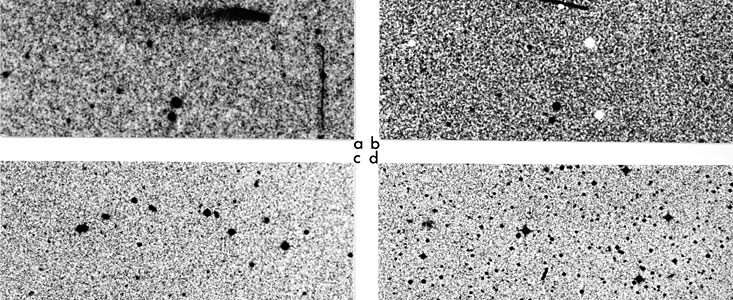Comunicato Stampa
A Minor Planet With a Tail!
18 Agosto 1992
Minor Planet (4015) was discovered in 1979. It is of the Earth–crossing "Apollo" type and moves in an elongated orbit around the Sun; the period of revolution is 4.3 years.
Strangely, an extrapolation backwards in time of the motion of (4015) has now shown that this minor planet is identical to an object with a tail, seen on two photographic plates which were obtained in 1949 with the Palomar Schmidt telescope. This object was already recognized on the plates in 1949 and classified as a comet. It was named after the Palomar discoverers as Comet Wilson–Harrington.
A careful investigation has shown that the 1949 tail is real, and is not just a photographic effect. Until now, no minor planet has ever been found to have a tail; this is the first, observationally confirmed case. Minor Planet (4015) must therefore have had an "outburst'' in 1949.
One possible explanation is that the surface of an otherwise solid minor planet was partly covered with a layer of ice some of which evaporated in 1949 when the planet was near the Sun; another is that sometime between 1949 and 1979, a dying comet exhausted its supply of ices and that Minor Planet (4015) is in fact an inactive, "dead'' cometary nucleus.
The present photos illustrate this unique observation. They show Minor Planet (4015) = Comet Wilson–Harrington on (a) a blue- (12 min) and (b) a red-sensitive (45 min) plate, obtained on November 19, 1949, with the 48-inch Schmidt telescope at Palomar. The tail is well visible below and to the left of the trail, which reflects the comet's motion during the exposures. These images were enhanced at the ESO photographic laboratory in Garching in order to better show the tail. The vertical line in the lower right corner of (a) is an emulsion fault. In (c), the same sky field is shown on a recent plate obtained with the same telescope; there is no diffuse object in the field. Finally, in (d) a 1979 image of minor planet (4015) from a plate obtained with the 48-inch UK Schmidt telescope demonstrates the sharpness of the short trail (at the centre) – there is absolutely no tail visible.
All photos are reproduced at the same scale, approx. 4 arcsec/mm; North is up and east is to the left. On (a) and (b), the distance from the Earth and the Sun was 34 million km and 172 million km, respectively; on (d) the corresponding distances were 58 million and 178 million km. The object appears brighter in 1949 (a, b) than in 1979 (d), partly because it was closer to the Earth, but most probably also because it was at that time surrounded by a small dust cloud.
Sul Comunicato Stampa
| Comunicato Stampa N": | eso9212 |
| Nome: | Comet Wilson-Harrington, Minor Planet (4015) |
| Tipo: | Solar System : Interplanetary Body Solar System : Interplanetary Body : Comet : Tail |
| Facility: | Other |






